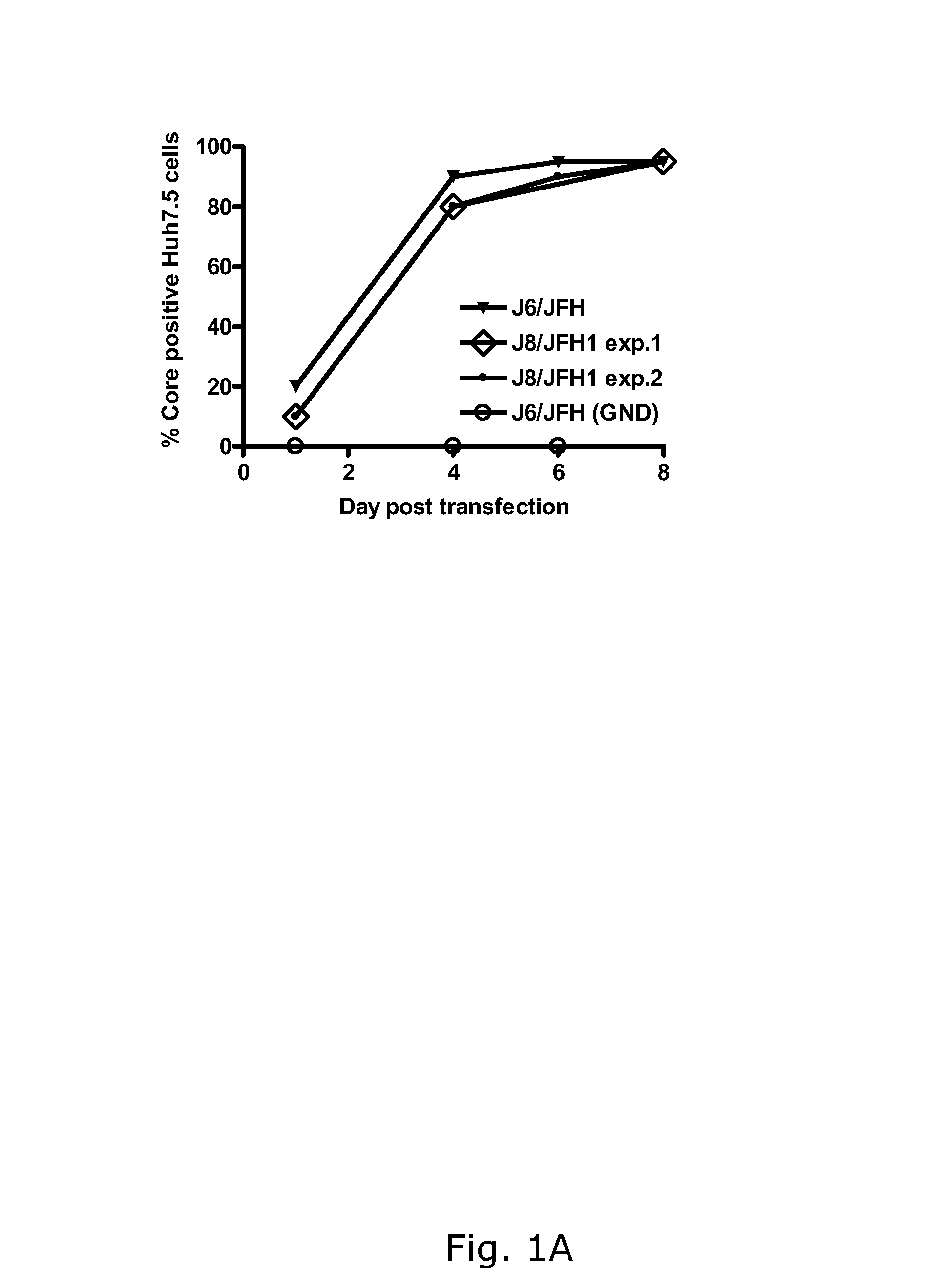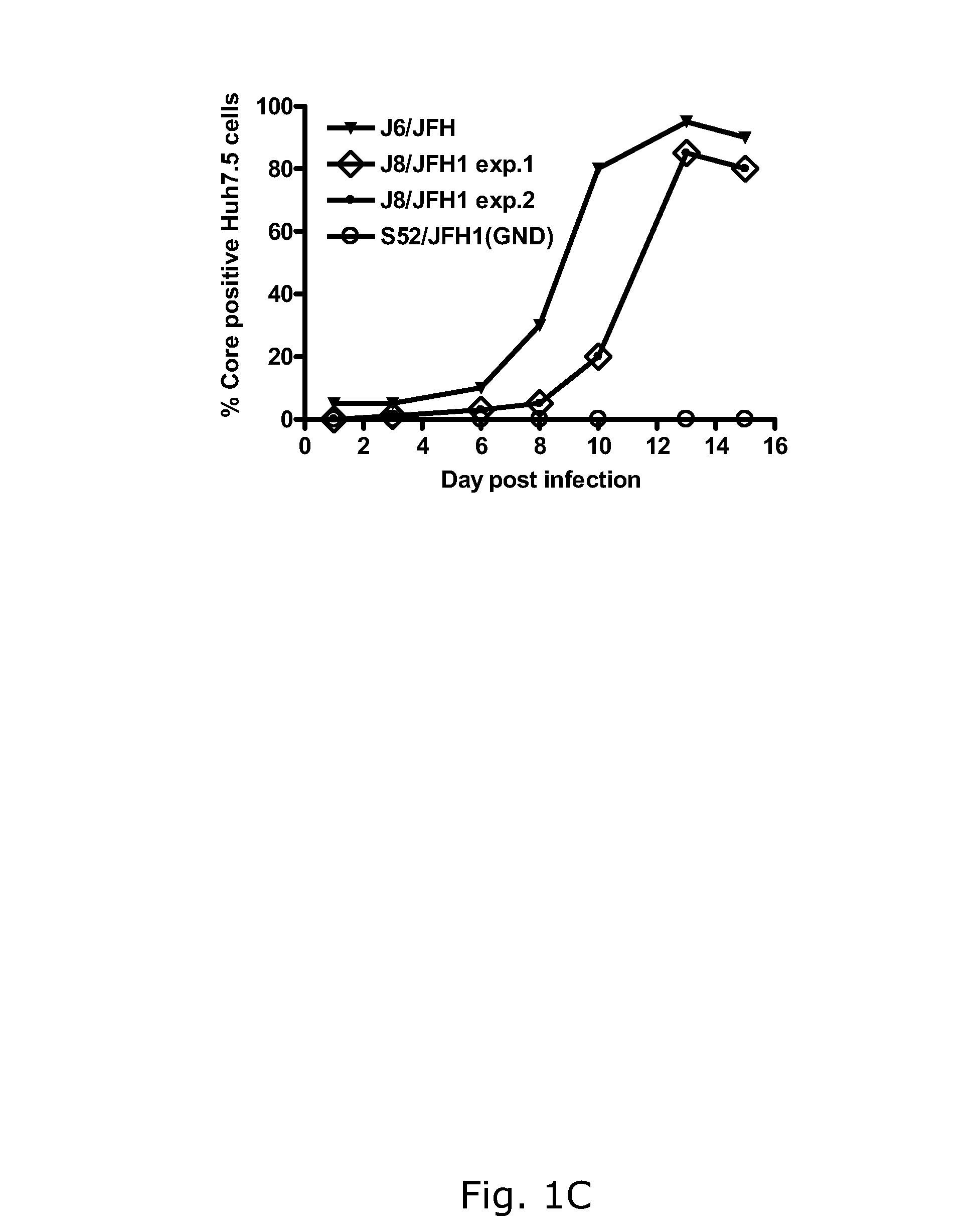Efficient cell culture system for hepatitis C virus genotype 2B
a cell culture system and hepatitis c virus technology, applied in the field of infectious recombinant hepatitis c genotype 2 viruses, can solve the problems of hepatocellular carcinoma, hcv research has been hampered, and the risk of liver cirrhosis is increased, so as to reduce the inhibition of replication and high mutation rate of the hcv genome
- Summary
- Abstract
- Description
- Claims
- Application Information
AI Technical Summary
Benefits of technology
Problems solved by technology
Method used
Image
Examples
example 1
Cell Culture Adaptation of Intergenotypic 2b / 2a Recombinant (J8 / JFH1)
[0190]In two independent RNA transfections of Huh7.5 cells, J8 / JFH1 spread comparably to J6 / JFH with approximately 20% and 80% HCV antigen positive cells on days 1 and 4, respectively (FIG. 1A). The supernatant infectivity titers increased from ˜101.5 TCID50 / mL on day 1 to ˜103.5 TCID50 / mL on day 4 (FIG. 1B). During viral passage (FIG. 1C), HCV RNA and infectivity titers were ˜107 IU / mL (FIG. 1D) and ˜104.5 TCID50 / mL (data not shown), respectively. Analysis of recovered viruses (days 10 and 13 post-infection, respectively) showed that J8 / JFH1 was genetically stable in two first passages performed from the first transfection (FIGS. 1C and D). In the passage of virus from the second transfection (FIGS. 1C and D), G4458A (R1373Q) was present as a 50 / 50 quasispecies with the original sequence (virus from day 13 post-infection).
example 2
Titrated Stocks of Genotype 1, 2 and 6 Viruses
[0191]The supernatant virus stocks of the JFH1-based intergenotypic recombinants, as well as J6 / JFH were characterized (Table 3). Infectivity titers ranged from 103.7 to 105.2 TCID50 / mL and HCV RNA titers ranged from 107.0 to 107.6 IU / mL with specific infectivities (defined as infectious titer relative to the HCV RNA titer) of 1 / 251-1 / 3901 TCID50 / IU.
[0192]There was a good correlation between the infectivity titers determined as TCID50 / mL and FFU / mL, respectively (Table 3).
example 3
Comparative Kinetic Studies of Intergenotypic Viruses
[0193]To further characterize the different genotype viruses, a kinetic experiment with genotype 1, 2 and 6 recombinants was performed. After inoculation of Huh7.5 cultures with the respective stock viruses at an MOI of 0.003, efficient spread in 5-10 days (FIG. 2A) was observed, paralleled by a 2-3 log increase in HCV RNA titers to peak titers of >107 IU / mL (FIG. 2B). In addition, an increase in intracellular Core and NS5A antigen by microscopy based image analyses was observed (FIG. 2C, D). In contrast, increasing infection with genotypes 1-6 did not lead to a change in the average lipid content per cell that was greater than the range of natural variation observed for non-infected cultures (FIG. 5). At peak infection (defined as the first time point with supernatant HCV RNA titers 107 IU / mL), intracellular HCV RNA and intra- and extracellular infectivity titers were measured (Table 4). Intracellular specific infectivity was at ...
PUM
| Property | Measurement | Unit |
|---|---|---|
| volume | aaaaa | aaaaa |
| volume | aaaaa | aaaaa |
| volume | aaaaa | aaaaa |
Abstract
Description
Claims
Application Information
 Login to View More
Login to View More - R&D
- Intellectual Property
- Life Sciences
- Materials
- Tech Scout
- Unparalleled Data Quality
- Higher Quality Content
- 60% Fewer Hallucinations
Browse by: Latest US Patents, China's latest patents, Technical Efficacy Thesaurus, Application Domain, Technology Topic, Popular Technical Reports.
© 2025 PatSnap. All rights reserved.Legal|Privacy policy|Modern Slavery Act Transparency Statement|Sitemap|About US| Contact US: help@patsnap.com



